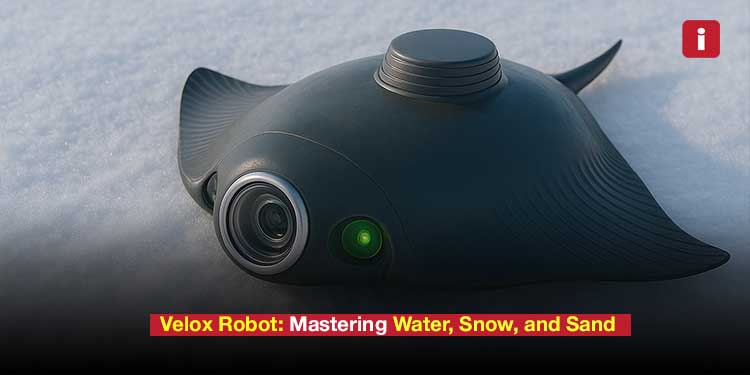A Stingray That Crawls | The Future of Amphibious Robotics
In a remarkable fusion of nature and engineering, Pliant Energy Systems has created the Velox robot, a bio-inspired machine that glides through water like a stingray and crawls across land with the finesse of a millipede. Unlike traditional underwater drones or land rovers, Velox uses a unique fin-based propulsion system that allows it to transition seamlessly across radically different terrains—water, sand, snow, pebbles, ice, and more—without any mechanical switching or wheels.
The robot’s soft fins are powered by hyperbolic wave patterns, a complex sinusoidal movement that replicates the natural undulations of a stingray’s fins. These traveling waves create continuous contact with the surrounding medium, providing both thrust in aquatic environments and traction on unstable land surfaces. Whether navigating a coral reef, crawling up a beach, or skating across a frozen lake, Velox delivers consistent performance powered by the elegance of biomimicry.
Engineering Elegance | The Science Behind the Motion
At the heart of Velox lies its soft robotics design, which replaces traditional wheels or propellers with ribbon-like fins made of flexible, durable materials. These fins are driven by a series of compact actuators that produce wave-like motion, enabling the robot to generate lift, propulsion, and directional control with minimal energy consumption. Because the fins are compliant and non-rigid, the robot can adapt to unexpected terrain changes, squeeze through narrow passages, and operate in vegetation-dense environments without getting tangled or stuck.
Velox is also equipped with onboard sensors and an adaptive control system. As the robot moves, it collects real-time data about the terrain and responds by adjusting its fin movements. This kind of terrain-aware intelligence ensures smooth movement whether it’s swimming through open water or crawling over uneven ice. On land, the fins distribute pressure evenly, preventing the robot from sinking into soft terrain like snow or sand. In water, the motion resembles a stingray’s graceful glide, quiet, efficient, and ideal for sensitive ecosystems.
Built for Real-World Challenges
The applications of the Velox robot extend far beyond laboratory demonstrations. It has already been deployed in military and environmental testing, including US Marine Corps demonstrations for amphibious logistics missions. Velox can carry payloads like medical supplies or equipment from ship to shore, navigating beachheads and surf zones without needing docks or external propulsion. In colder regions, its ice-capable mobility allows it to “skate” across frozen surfaces—enabled by a phenomenon known as anisotropic friction, similar to how human skaters shift their weight to glide smoothly.
Researchers and environmentalists are also eyeing Velox for its potential in polar research, wildlife monitoring, and underwater inspection. Because its fins don’t disturb sediment or aquatic plants, it’s well-suited for sensitive habitats like coral reefs, tidal marshes, or kelp forests. Pliant Energy even imagines Velox playing a role in deep-sea mining, collecting seafloor materials with minimal environmental disruption.
Innovation in Progress: From Prototype to Deployment
Velox is still in the development and field-testing phase, but its journey has been impressive. In 2024, Pliant Energy received an $8 million contract from the U.S. Office of Naval Research to build an autonomous version of the robot for open-ocean missions. MIT’s Marine Autonomy Lab is also working to integrate advanced navigation software, giving Velox the ability to perform autonomous underwater and land-based tasks. The robot has been showcased at major tech events—including a hands-on demo at Jeff Bezos’s MARS conference—and was recently selected for NYC’s Pilots at BAT program to monitor urban coastlines.
Beyond military and scientific use, Velox could soon play a role in the offshore wind industry, inspecting submerged turbines and power lines. Its minimal disturbance and unique locomotion style make it ideal for tasks where both accuracy and ecological sensitivity are crucial.
A New Wave in Robotics
What makes Velox truly unique isn’t just its amphibious ability or futuristic appearance, it’s the underlying philosophy. This robot is not trying to dominate the environment; it’s designed to coexist with nature, drawing inspiration from millions of years of evolution. By observing and imitating the efficient biomechanics of stingrays, engineers have created a robot that moves with grace, intelligence, and versatility, across ecosystems that were once difficult or impossible for machines to traverse.
As soft robotics and bio-inspired engineering continue to evolve, Velox stands out as a powerful symbol of what the next generation of intelligent machines might look like: agile, adaptable, and deeply connected to the natural world.
Final Thoughts
The Velox robot by Pliant Energy isn’t just a marvel of modern engineering—it’s a vision of where robotics is headed. Whether it’s patrolling coastlines, supporting rescue operations, studying wildlife, or exploring the ocean floor, Velox is showing us how soft, adaptive machines can thrive where rigid ones fail. In the world of robotics, it’s not just about brute strength anymore. It’s about flexibility, awareness, and harmony with the world around us.













































